Enterprise System Analysis: ERP Implementation and Drawbacks Report
VerifiedAdded on 2020/04/07
|9
|1614
|342
Report
AI Summary
This report provides an in-depth analysis of Enterprise Systems, particularly focusing on Enterprise Resource Planning (ERP) systems. It begins by differentiating between work processes and practices within an ERP context and explores the crucial aspects of selecting suitable ERP packages, including vendor reputation, system functionality, and associated costs. The report outlines the ERP software selection process, detailing key steps such as assessing business requirements, communicating with vendors, and adapting software to align with organizational practices. Furthermore, it examines the benefits of ERP systems, such as improved information management, workflow optimization, and enhanced transparency. The report also critically assesses the potential drawbacks of ERP implementation, including high costs, lengthy implementation times, customization complexities, and the importance of user training. The report concludes by referencing relevant literature to support the analysis and findings.
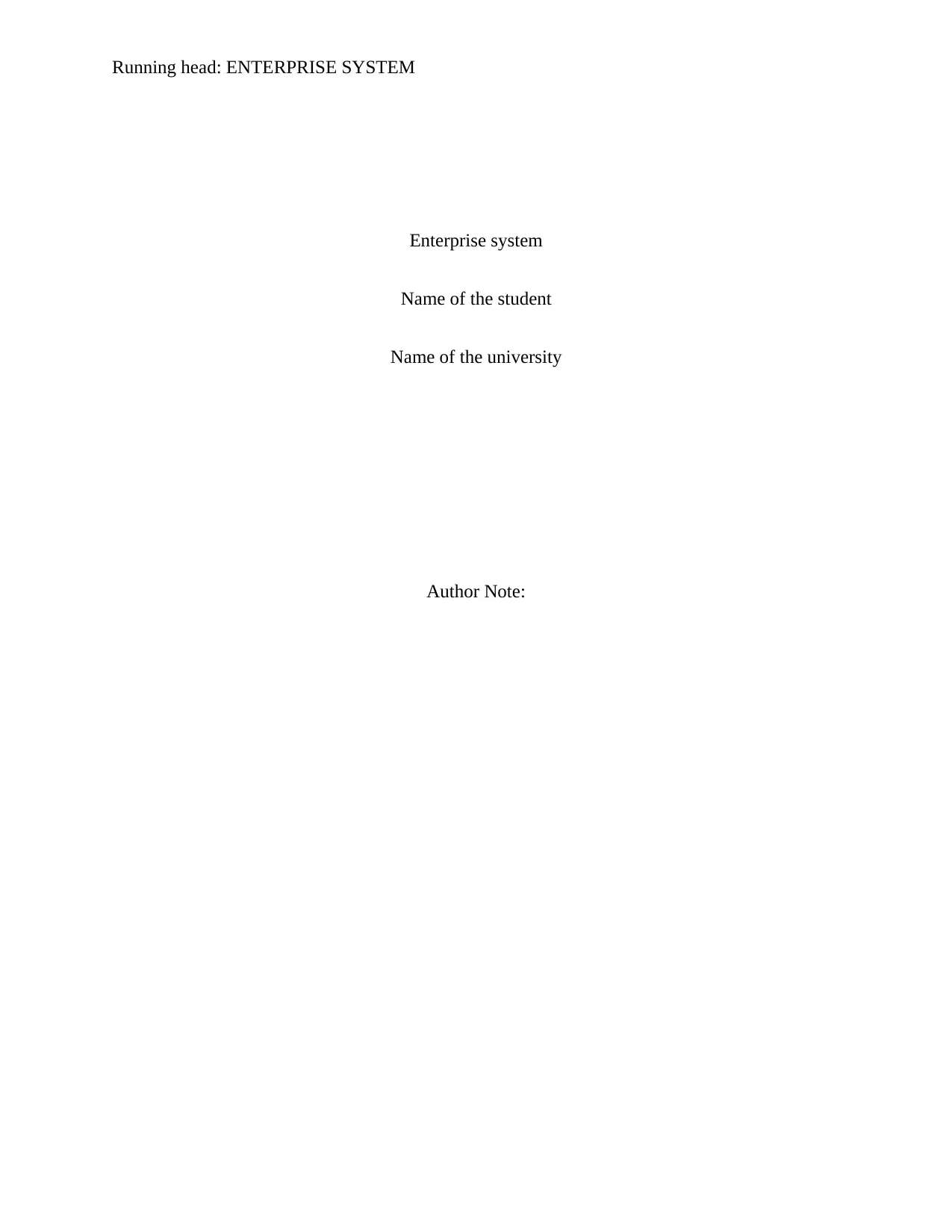
Running head: ENTERPRISE SYSTEM
Enterprise system
Name of the student
Name of the university
Author Note:
Enterprise system
Name of the student
Name of the university
Author Note:
Paraphrase This Document
Need a fresh take? Get an instant paraphrase of this document with our AI Paraphraser

2
ENTERPRISE SYSTEM
Table of Contents
Activity 1.........................................................................................................................................3
Question 1........................................................................................................................................3
Ability to differentiate work processes and practices to gain advantage in the market place.........3
Question 2........................................................................................................................................3
Ability to select packages that best suit existing practices..............................................................3
ERP software selection process.......................................................................................................4
Question 3........................................................................................................................................5
The Adaption and development of Software to suit the organization’s current practices...............5
Activity 2.........................................................................................................................................6
Potential Drawbacks of ERP System...............................................................................................6
References........................................................................................................................................8
ENTERPRISE SYSTEM
Table of Contents
Activity 1.........................................................................................................................................3
Question 1........................................................................................................................................3
Ability to differentiate work processes and practices to gain advantage in the market place.........3
Question 2........................................................................................................................................3
Ability to select packages that best suit existing practices..............................................................3
ERP software selection process.......................................................................................................4
Question 3........................................................................................................................................5
The Adaption and development of Software to suit the organization’s current practices...............5
Activity 2.........................................................................................................................................6
Potential Drawbacks of ERP System...............................................................................................6
References........................................................................................................................................8
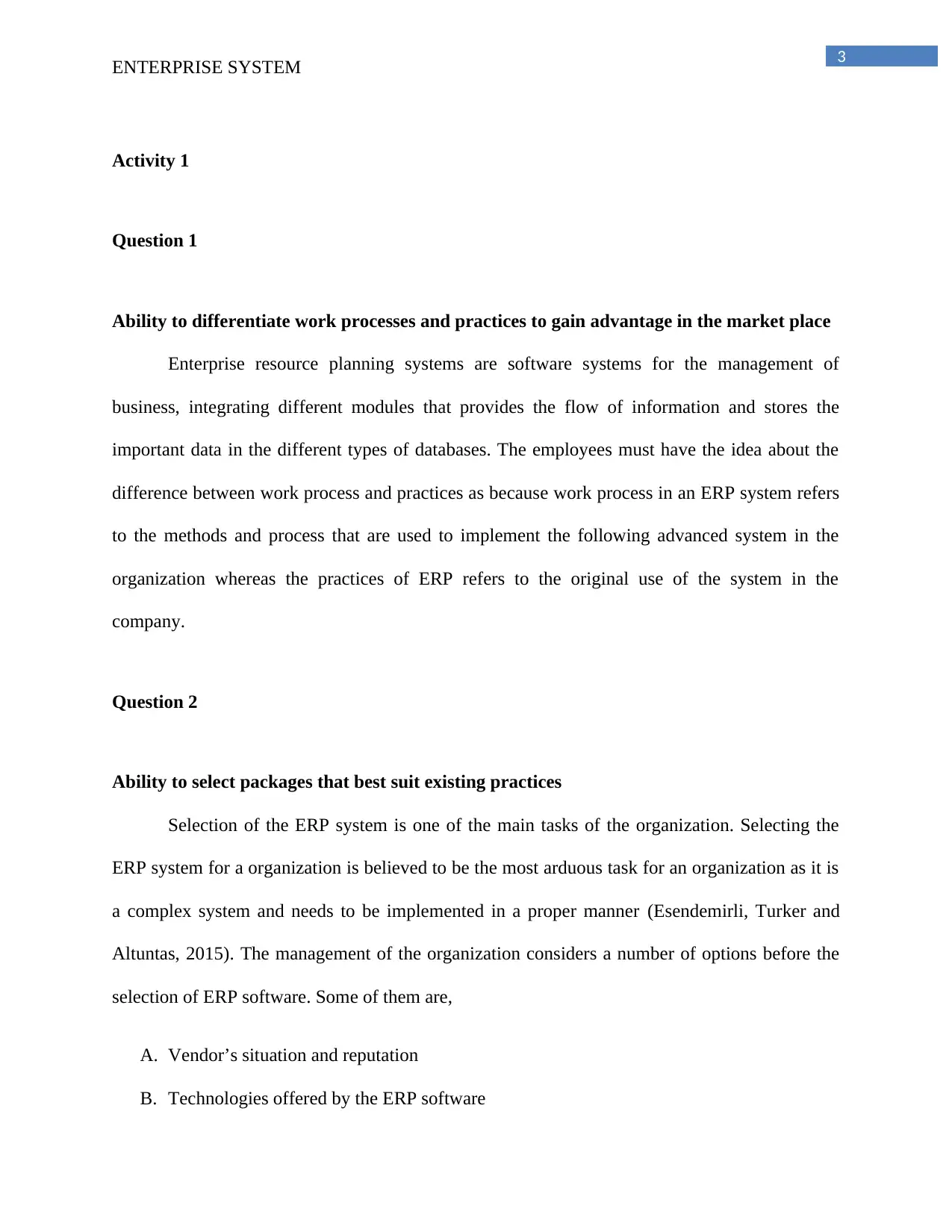
3
ENTERPRISE SYSTEM
Activity 1
Question 1
Ability to differentiate work processes and practices to gain advantage in the market place
Enterprise resource planning systems are software systems for the management of
business, integrating different modules that provides the flow of information and stores the
important data in the different types of databases. The employees must have the idea about the
difference between work process and practices as because work process in an ERP system refers
to the methods and process that are used to implement the following advanced system in the
organization whereas the practices of ERP refers to the original use of the system in the
company.
Question 2
Ability to select packages that best suit existing practices
Selection of the ERP system is one of the main tasks of the organization. Selecting the
ERP system for a organization is believed to be the most arduous task for an organization as it is
a complex system and needs to be implemented in a proper manner (Esendemirli, Turker and
Altuntas, 2015). The management of the organization considers a number of options before the
selection of ERP software. Some of them are,
A. Vendor’s situation and reputation
B. Technologies offered by the ERP software
ENTERPRISE SYSTEM
Activity 1
Question 1
Ability to differentiate work processes and practices to gain advantage in the market place
Enterprise resource planning systems are software systems for the management of
business, integrating different modules that provides the flow of information and stores the
important data in the different types of databases. The employees must have the idea about the
difference between work process and practices as because work process in an ERP system refers
to the methods and process that are used to implement the following advanced system in the
organization whereas the practices of ERP refers to the original use of the system in the
company.
Question 2
Ability to select packages that best suit existing practices
Selection of the ERP system is one of the main tasks of the organization. Selecting the
ERP system for a organization is believed to be the most arduous task for an organization as it is
a complex system and needs to be implemented in a proper manner (Esendemirli, Turker and
Altuntas, 2015). The management of the organization considers a number of options before the
selection of ERP software. Some of them are,
A. Vendor’s situation and reputation
B. Technologies offered by the ERP software
⊘ This is a preview!⊘
Do you want full access?
Subscribe today to unlock all pages.

Trusted by 1+ million students worldwide
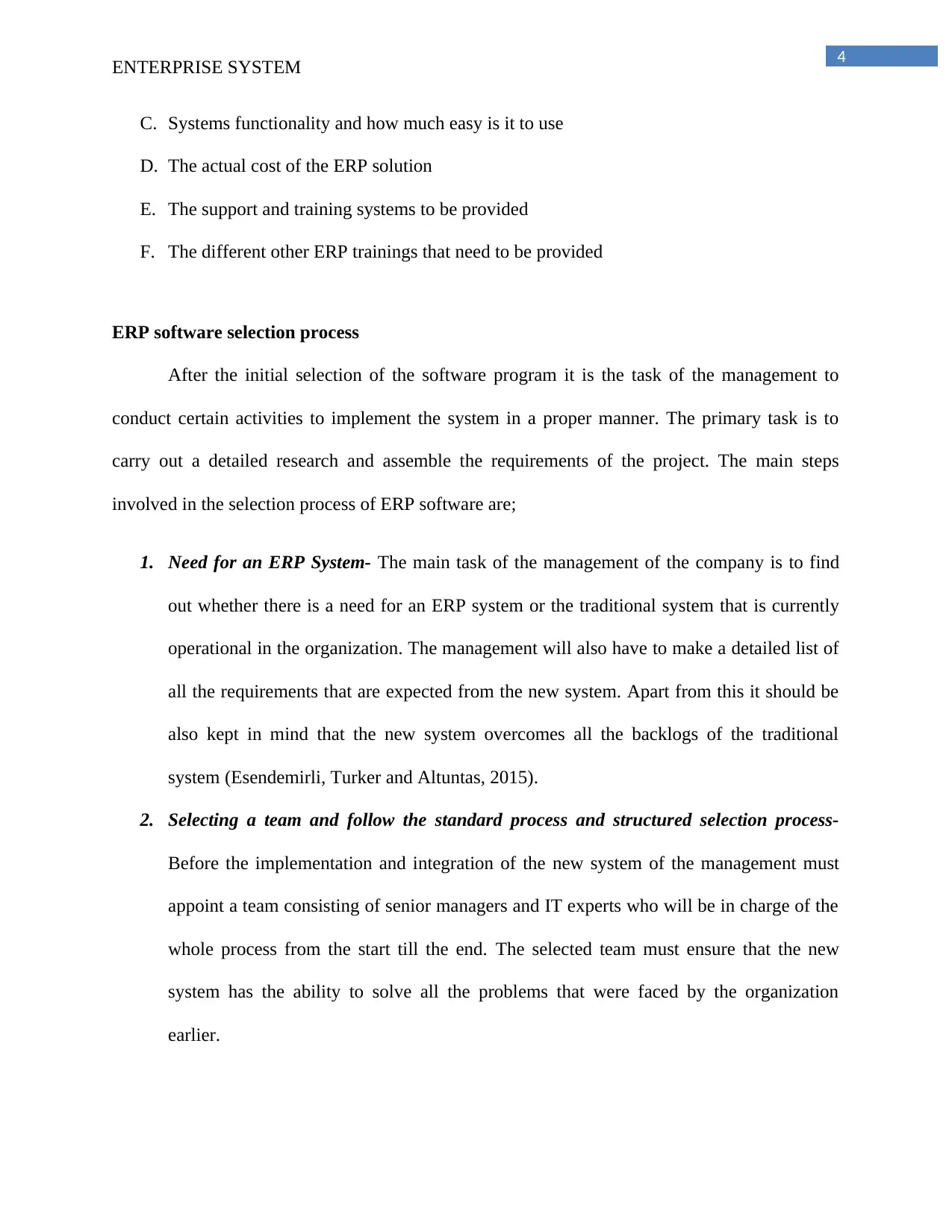
4
ENTERPRISE SYSTEM
C. Systems functionality and how much easy is it to use
D. The actual cost of the ERP solution
E. The support and training systems to be provided
F. The different other ERP trainings that need to be provided
ERP software selection process
After the initial selection of the software program it is the task of the management to
conduct certain activities to implement the system in a proper manner. The primary task is to
carry out a detailed research and assemble the requirements of the project. The main steps
involved in the selection process of ERP software are;
1. Need for an ERP System- The main task of the management of the company is to find
out whether there is a need for an ERP system or the traditional system that is currently
operational in the organization. The management will also have to make a detailed list of
all the requirements that are expected from the new system. Apart from this it should be
also kept in mind that the new system overcomes all the backlogs of the traditional
system (Esendemirli, Turker and Altuntas, 2015).
2. Selecting a team and follow the standard process and structured selection process-
Before the implementation and integration of the new system of the management must
appoint a team consisting of senior managers and IT experts who will be in charge of the
whole process from the start till the end. The selected team must ensure that the new
system has the ability to solve all the problems that were faced by the organization
earlier.
ENTERPRISE SYSTEM
C. Systems functionality and how much easy is it to use
D. The actual cost of the ERP solution
E. The support and training systems to be provided
F. The different other ERP trainings that need to be provided
ERP software selection process
After the initial selection of the software program it is the task of the management to
conduct certain activities to implement the system in a proper manner. The primary task is to
carry out a detailed research and assemble the requirements of the project. The main steps
involved in the selection process of ERP software are;
1. Need for an ERP System- The main task of the management of the company is to find
out whether there is a need for an ERP system or the traditional system that is currently
operational in the organization. The management will also have to make a detailed list of
all the requirements that are expected from the new system. Apart from this it should be
also kept in mind that the new system overcomes all the backlogs of the traditional
system (Esendemirli, Turker and Altuntas, 2015).
2. Selecting a team and follow the standard process and structured selection process-
Before the implementation and integration of the new system of the management must
appoint a team consisting of senior managers and IT experts who will be in charge of the
whole process from the start till the end. The selected team must ensure that the new
system has the ability to solve all the problems that were faced by the organization
earlier.
Paraphrase This Document
Need a fresh take? Get an instant paraphrase of this document with our AI Paraphraser

5
ENTERPRISE SYSTEM
3. Assess business requirements and resource constraints- The appointed team lists the
needs for the business and assess whether they are present within the ERP system
(Scarbrough, Robertson and Swan, 2015). The team also makes sure that there is an
adaptability and responsiveness of the system.
4. Communicating with potential vendors- Communicating with the potential vendors is
one of the most important tasks that is needed to be completed when an ERP system is
implemented in the system. Some of the important tasks that are needed to be considered
while communicating with the potential vendors are;
A. What application areas are needed to cover?
B. How many clients does one have?
C. What is the type of service provided by the company?
D. What is the total area of operations of the company? `
Question 3
The Adaption and development of Software to suit the organization’s current practices
The adaption and the development of the software buy the organization is the most
important task that needs to be done by the management to outclass and outperform some
limitations of the earlier software and manual labor (Elbardan et al. 2016). Some of them
are,
ERP system helps to have a better information management through the automation of
business- The performance metrics and the measurements are very important for the
evaluation of business progress and also helps to setup the future goals of the
ENTERPRISE SYSTEM
3. Assess business requirements and resource constraints- The appointed team lists the
needs for the business and assess whether they are present within the ERP system
(Scarbrough, Robertson and Swan, 2015). The team also makes sure that there is an
adaptability and responsiveness of the system.
4. Communicating with potential vendors- Communicating with the potential vendors is
one of the most important tasks that is needed to be completed when an ERP system is
implemented in the system. Some of the important tasks that are needed to be considered
while communicating with the potential vendors are;
A. What application areas are needed to cover?
B. How many clients does one have?
C. What is the type of service provided by the company?
D. What is the total area of operations of the company? `
Question 3
The Adaption and development of Software to suit the organization’s current practices
The adaption and the development of the software buy the organization is the most
important task that needs to be done by the management to outclass and outperform some
limitations of the earlier software and manual labor (Elbardan et al. 2016). Some of them
are,
ERP system helps to have a better information management through the automation of
business- The performance metrics and the measurements are very important for the
evaluation of business progress and also helps to setup the future goals of the
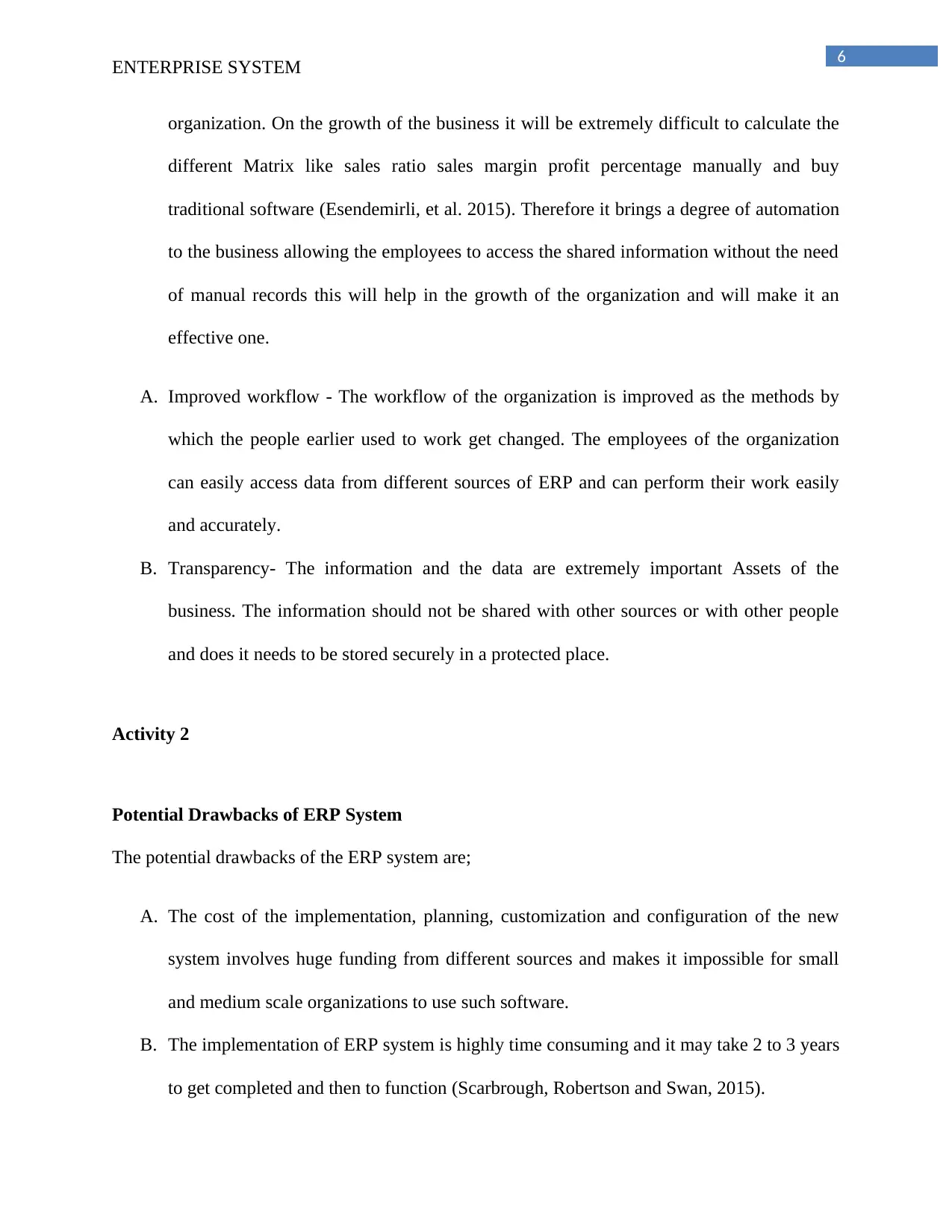
6
ENTERPRISE SYSTEM
organization. On the growth of the business it will be extremely difficult to calculate the
different Matrix like sales ratio sales margin profit percentage manually and buy
traditional software (Esendemirli, et al. 2015). Therefore it brings a degree of automation
to the business allowing the employees to access the shared information without the need
of manual records this will help in the growth of the organization and will make it an
effective one.
A. Improved workflow - The workflow of the organization is improved as the methods by
which the people earlier used to work get changed. The employees of the organization
can easily access data from different sources of ERP and can perform their work easily
and accurately.
B. Transparency- The information and the data are extremely important Assets of the
business. The information should not be shared with other sources or with other people
and does it needs to be stored securely in a protected place.
Activity 2
Potential Drawbacks of ERP System
The potential drawbacks of the ERP system are;
A. The cost of the implementation, planning, customization and configuration of the new
system involves huge funding from different sources and makes it impossible for small
and medium scale organizations to use such software.
B. The implementation of ERP system is highly time consuming and it may take 2 to 3 years
to get completed and then to function (Scarbrough, Robertson and Swan, 2015).
ENTERPRISE SYSTEM
organization. On the growth of the business it will be extremely difficult to calculate the
different Matrix like sales ratio sales margin profit percentage manually and buy
traditional software (Esendemirli, et al. 2015). Therefore it brings a degree of automation
to the business allowing the employees to access the shared information without the need
of manual records this will help in the growth of the organization and will make it an
effective one.
A. Improved workflow - The workflow of the organization is improved as the methods by
which the people earlier used to work get changed. The employees of the organization
can easily access data from different sources of ERP and can perform their work easily
and accurately.
B. Transparency- The information and the data are extremely important Assets of the
business. The information should not be shared with other sources or with other people
and does it needs to be stored securely in a protected place.
Activity 2
Potential Drawbacks of ERP System
The potential drawbacks of the ERP system are;
A. The cost of the implementation, planning, customization and configuration of the new
system involves huge funding from different sources and makes it impossible for small
and medium scale organizations to use such software.
B. The implementation of ERP system is highly time consuming and it may take 2 to 3 years
to get completed and then to function (Scarbrough, Robertson and Swan, 2015).
⊘ This is a preview!⊘
Do you want full access?
Subscribe today to unlock all pages.

Trusted by 1+ million students worldwide
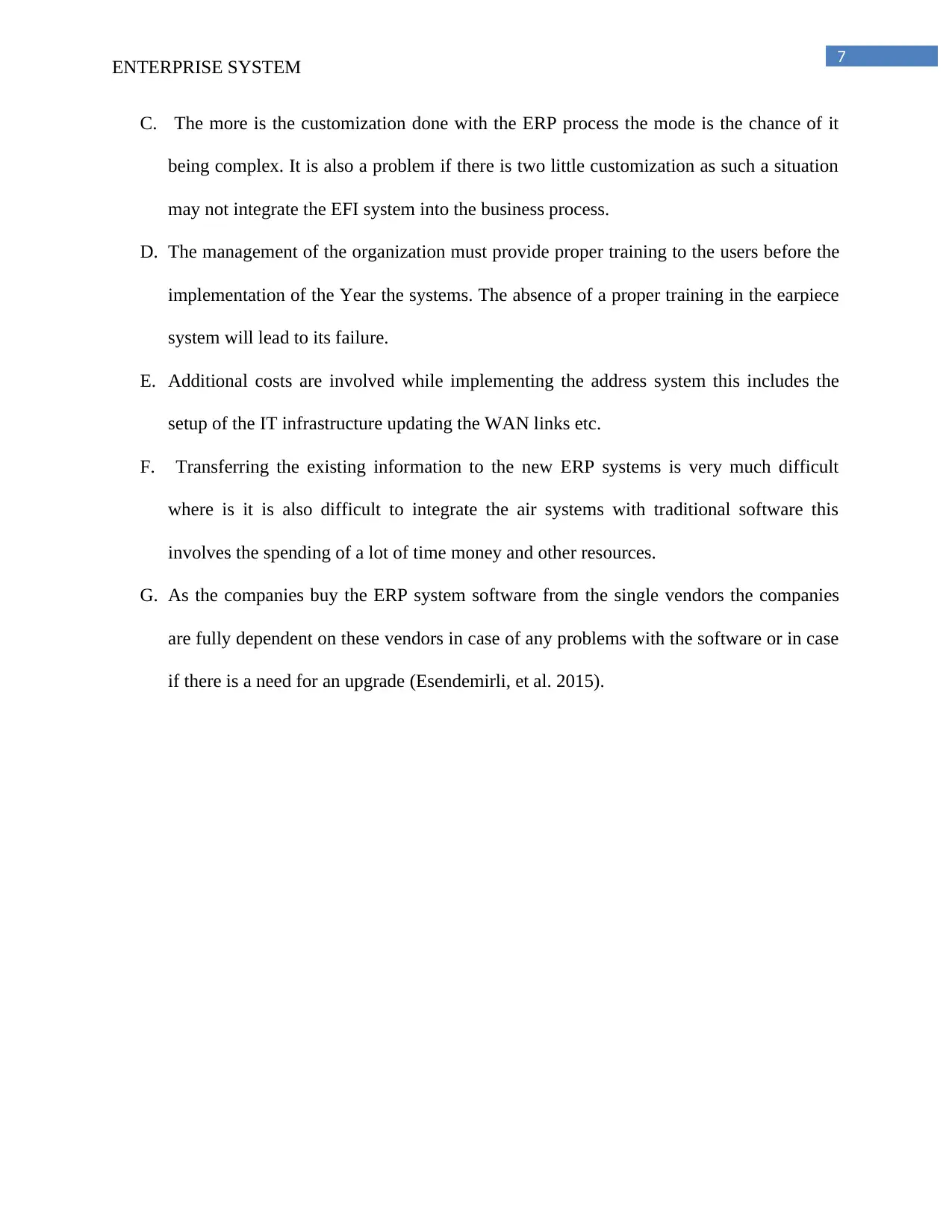
7
ENTERPRISE SYSTEM
C. The more is the customization done with the ERP process the mode is the chance of it
being complex. It is also a problem if there is two little customization as such a situation
may not integrate the EFI system into the business process.
D. The management of the organization must provide proper training to the users before the
implementation of the Year the systems. The absence of a proper training in the earpiece
system will lead to its failure.
E. Additional costs are involved while implementing the address system this includes the
setup of the IT infrastructure updating the WAN links etc.
F. Transferring the existing information to the new ERP systems is very much difficult
where is it is also difficult to integrate the air systems with traditional software this
involves the spending of a lot of time money and other resources.
G. As the companies buy the ERP system software from the single vendors the companies
are fully dependent on these vendors in case of any problems with the software or in case
if there is a need for an upgrade (Esendemirli, et al. 2015).
ENTERPRISE SYSTEM
C. The more is the customization done with the ERP process the mode is the chance of it
being complex. It is also a problem if there is two little customization as such a situation
may not integrate the EFI system into the business process.
D. The management of the organization must provide proper training to the users before the
implementation of the Year the systems. The absence of a proper training in the earpiece
system will lead to its failure.
E. Additional costs are involved while implementing the address system this includes the
setup of the IT infrastructure updating the WAN links etc.
F. Transferring the existing information to the new ERP systems is very much difficult
where is it is also difficult to integrate the air systems with traditional software this
involves the spending of a lot of time money and other resources.
G. As the companies buy the ERP system software from the single vendors the companies
are fully dependent on these vendors in case of any problems with the software or in case
if there is a need for an upgrade (Esendemirli, et al. 2015).
Paraphrase This Document
Need a fresh take? Get an instant paraphrase of this document with our AI Paraphraser
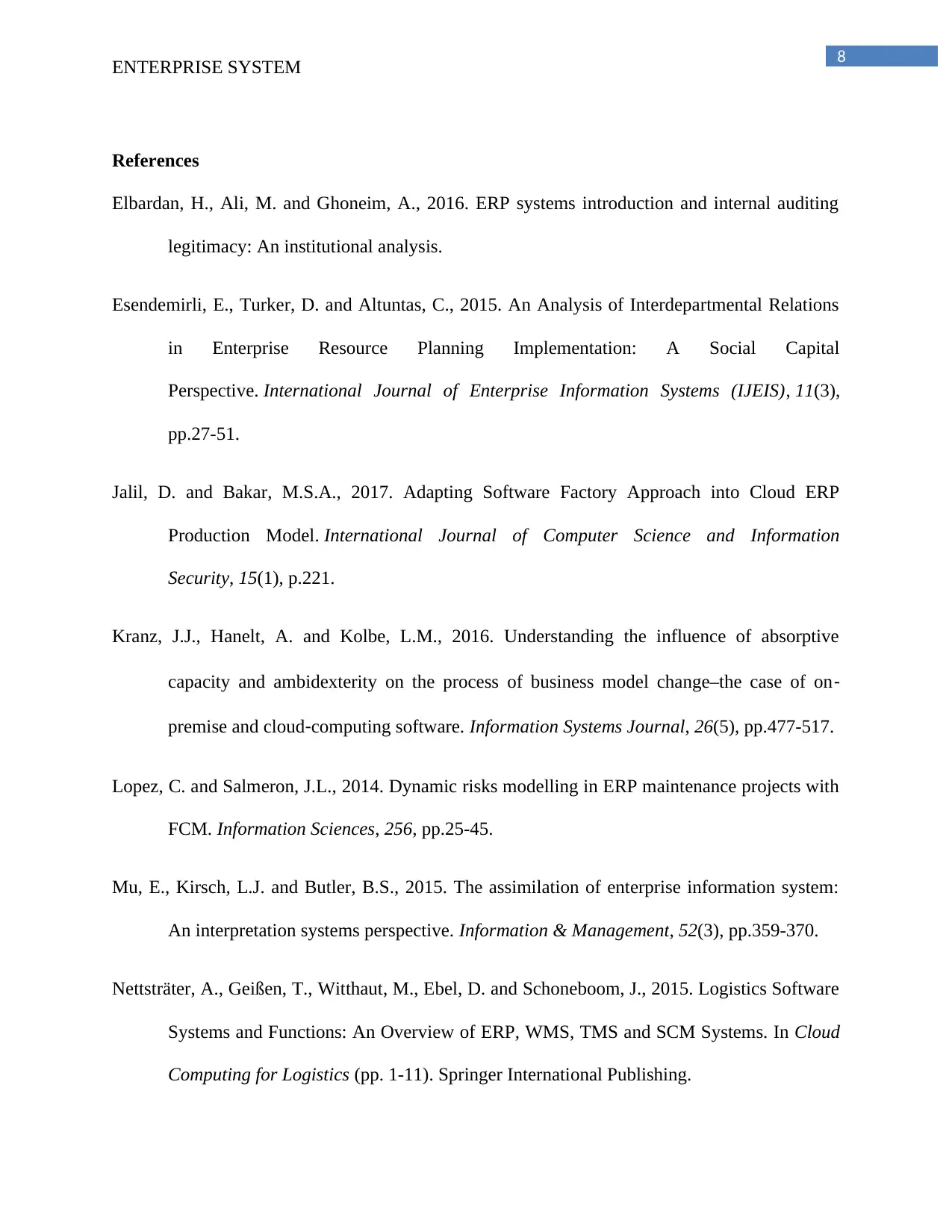
8
ENTERPRISE SYSTEM
References
Elbardan, H., Ali, M. and Ghoneim, A., 2016. ERP systems introduction and internal auditing
legitimacy: An institutional analysis.
Esendemirli, E., Turker, D. and Altuntas, C., 2015. An Analysis of Interdepartmental Relations
in Enterprise Resource Planning Implementation: A Social Capital
Perspective. International Journal of Enterprise Information Systems (IJEIS), 11(3),
pp.27-51.
Jalil, D. and Bakar, M.S.A., 2017. Adapting Software Factory Approach into Cloud ERP
Production Model. International Journal of Computer Science and Information
Security, 15(1), p.221.
Kranz, J.J., Hanelt, A. and Kolbe, L.M., 2016. Understanding the influence of absorptive
capacity and ambidexterity on the process of business model change–the case of on‐
premise and cloud‐computing software. Information Systems Journal, 26(5), pp.477-517.
Lopez, C. and Salmeron, J.L., 2014. Dynamic risks modelling in ERP maintenance projects with
FCM. Information Sciences, 256, pp.25-45.
Mu, E., Kirsch, L.J. and Butler, B.S., 2015. The assimilation of enterprise information system:
An interpretation systems perspective. Information & Management, 52(3), pp.359-370.
Nettsträter, A., Geißen, T., Witthaut, M., Ebel, D. and Schoneboom, J., 2015. Logistics Software
Systems and Functions: An Overview of ERP, WMS, TMS and SCM Systems. In Cloud
Computing for Logistics (pp. 1-11). Springer International Publishing.
ENTERPRISE SYSTEM
References
Elbardan, H., Ali, M. and Ghoneim, A., 2016. ERP systems introduction and internal auditing
legitimacy: An institutional analysis.
Esendemirli, E., Turker, D. and Altuntas, C., 2015. An Analysis of Interdepartmental Relations
in Enterprise Resource Planning Implementation: A Social Capital
Perspective. International Journal of Enterprise Information Systems (IJEIS), 11(3),
pp.27-51.
Jalil, D. and Bakar, M.S.A., 2017. Adapting Software Factory Approach into Cloud ERP
Production Model. International Journal of Computer Science and Information
Security, 15(1), p.221.
Kranz, J.J., Hanelt, A. and Kolbe, L.M., 2016. Understanding the influence of absorptive
capacity and ambidexterity on the process of business model change–the case of on‐
premise and cloud‐computing software. Information Systems Journal, 26(5), pp.477-517.
Lopez, C. and Salmeron, J.L., 2014. Dynamic risks modelling in ERP maintenance projects with
FCM. Information Sciences, 256, pp.25-45.
Mu, E., Kirsch, L.J. and Butler, B.S., 2015. The assimilation of enterprise information system:
An interpretation systems perspective. Information & Management, 52(3), pp.359-370.
Nettsträter, A., Geißen, T., Witthaut, M., Ebel, D. and Schoneboom, J., 2015. Logistics Software
Systems and Functions: An Overview of ERP, WMS, TMS and SCM Systems. In Cloud
Computing for Logistics (pp. 1-11). Springer International Publishing.
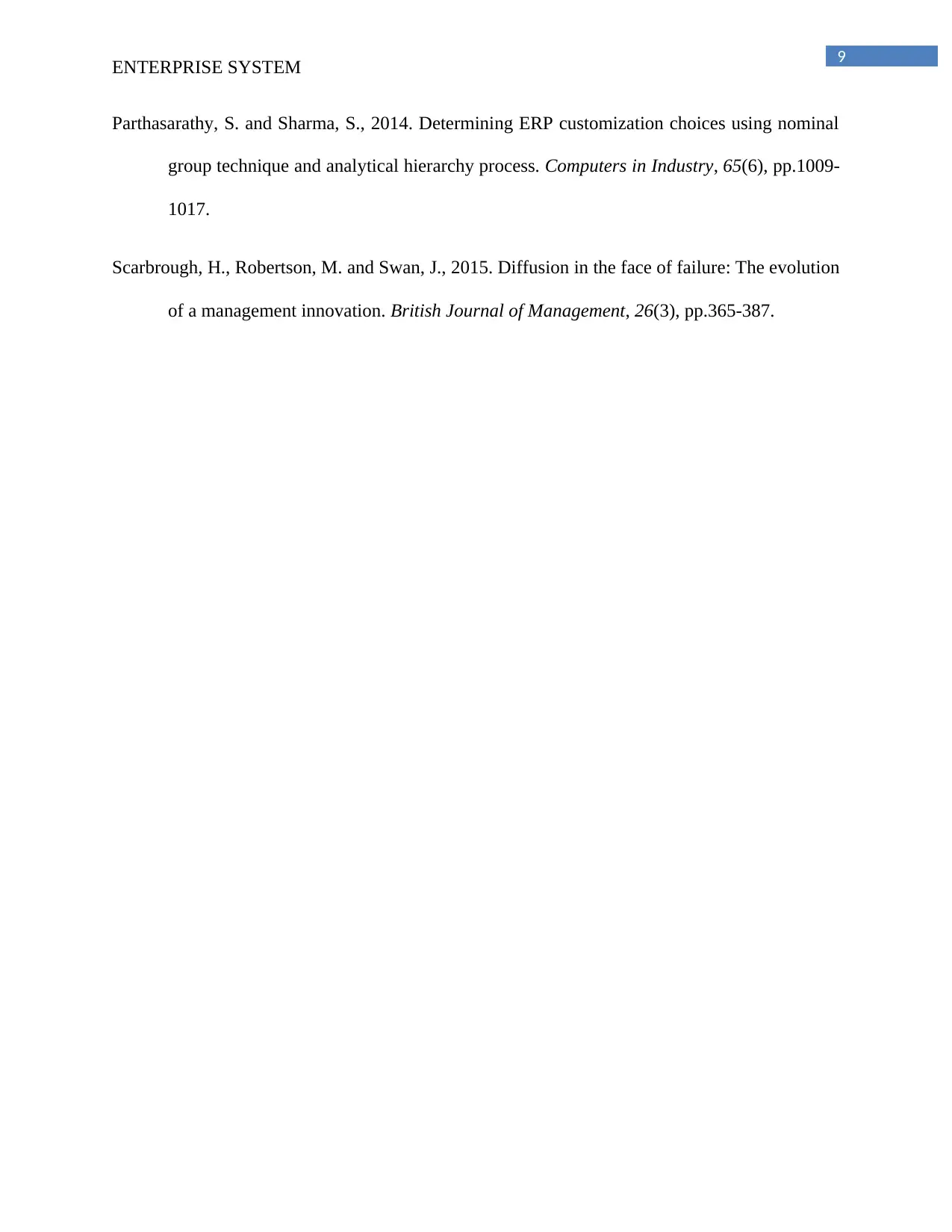
9
ENTERPRISE SYSTEM
Parthasarathy, S. and Sharma, S., 2014. Determining ERP customization choices using nominal
group technique and analytical hierarchy process. Computers in Industry, 65(6), pp.1009-
1017.
Scarbrough, H., Robertson, M. and Swan, J., 2015. Diffusion in the face of failure: The evolution
of a management innovation. British Journal of Management, 26(3), pp.365-387.
ENTERPRISE SYSTEM
Parthasarathy, S. and Sharma, S., 2014. Determining ERP customization choices using nominal
group technique and analytical hierarchy process. Computers in Industry, 65(6), pp.1009-
1017.
Scarbrough, H., Robertson, M. and Swan, J., 2015. Diffusion in the face of failure: The evolution
of a management innovation. British Journal of Management, 26(3), pp.365-387.
⊘ This is a preview!⊘
Do you want full access?
Subscribe today to unlock all pages.

Trusted by 1+ million students worldwide
1 out of 9
Related Documents
Your All-in-One AI-Powered Toolkit for Academic Success.
+13062052269
info@desklib.com
Available 24*7 on WhatsApp / Email
![[object Object]](/_next/static/media/star-bottom.7253800d.svg)
Unlock your academic potential
Copyright © 2020–2025 A2Z Services. All Rights Reserved. Developed and managed by ZUCOL.





